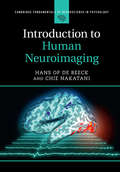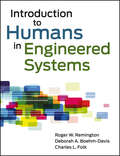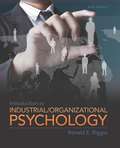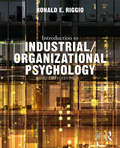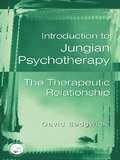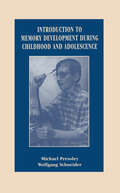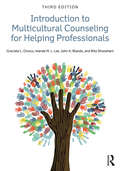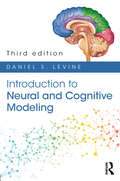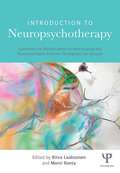- Table View
- List View
Introduction to Human Development and Family Studies
by Bridget A. Walsh Dana A. Weiser Lydia Deflorio Melissa M. BurnhamIntroduction to Human Development and Family Studies is the first text to introduce human development and family studies (HDFS) as inextricably linked areas of study, giving students a complex yet realistic view of individuals and families. Pioneers of research paradigms have acknowledged that the family is one setting in which human development occurs. Moreover, in many academic programs, the lines of these two disciplines blur and much work is inherently multidisciplinary and interdisciplinary. This book helps to fortify an understanding of HDFS and subareas within it. Vignettes from current HDFS students as well as new professionals, an overview of the lifespan stage(s) within the family context, a wide description of research methods and applications, current policy issues relevant to the area, and discussions of practice/careers coupled with strategies for pursuing specializations or careers in the area are hallmarks of this textbook. Introduction to Human Development and Family Studies is essential reading for students new to the major and minor wanting to know: What is HDFS? Who are the people involved in HDFS? Why is HDFS important? How does theory and research inform work in HDFS? What does the pursuit of being an ethical professional require? What are the key areas in HDFS? Incredibly user-friendly both on the page and online, the text also features the following resources: Chapter Summaries where the main points of each chapter are pinpointed at the end of every chapter for review and study. Key Terms listed and defined within the margins of every chapter, a complete Glossary at the end of the text, and Flashcards online for additional review and study. Challenge: Integration section at the end of each chapter that underscores concepts from the chapter and draws connections between content presented in other chapters. Journal Questions to encourage reflection about the content and encourage thinking about some of the content coupled with students’ own experiences. Suggested Resources that lists relevant websites, books, articles, and video links for further study. A Closer Look at Applied Experiences Appendix outlines the internship process and shows how the internship experience can be meaningful and useful, and a Consuming Research Appendix that focuses on what it means to be a consumer of research, the knowledge and skills consumers need, and considerations for transitioning from a consumer of research to a producer of research.
Introduction to Human Memory (Psychology Library Editions: Memory)
by Vernon GreggOriginally published in 1986, this book was written for undergraduates who had completed an introductory course in psychology, and aimed to acquaint the student with the core of recent experimental findings and theoretical ideas concerning human memory. Each chapter deals with a specific area of memory research but care is taken to build on what has been covered in preceding chapters, so providing an integrated treatment of the subject. Thus, the book can comfortably be read from cover to cover, or selected issues can be referred to in isolation. Important features of the book include discussion of fundamental issues about the nature of the scientific process, the role of models and theories in it, and the historical development of models of human memory. Also, the treatment of ‘Forgetting’ includes chapters on motivational aspects (psychopathological forgetting, post-hypnotic amnesia, and directed forgetting), and organic amnesia.
Introduction to Human Neuroimaging (Cambridge Fundamentals of Neuroscience in Psychology)
by Hans Op de Beeck Chie NakataniDeveloped specifically for students in the behavioral and brain sciences, this is the only textbook that provides an accessible and practical overview of the range of human neuroimaging techniques. Methods covered include functional and structural magnetic resonance imaging, positron emission tomography, electroencephalography, magnetoencephalography, multimodal imaging, and various brain stimulation methods. Experimental design, image processing, and statistical inference are also addressed, with chapters for both basic and more advanced data analyses. Key concepts are illustrated through research studies on the relationship between brain and behavior, and practice questions are included throughout to test knowledge and aid self-study. Offering just the right amount of detail for understanding how major imaging techniques can be applied to answer neuroscientific questions, and the practical skills needed for future research, this is an essential text for advanced undergraduate and graduate students in psychology, neuroscience, and cognitive science programs taking introductory courses on human neuroimaging.
Introduction to Human-Animal Interaction: Insights from Social and Life Sciences
by Laëtitia Maréchal van der Zee, EmileIntroduction to Human-Animal Interaction focuses on the human dimension of interacting with other animals. This book introduces recent developments, theories, and debates in the relatively new research area of Human-Animal Interaction (HAI) and focuses on the social and life sciences aspect of these interactions. Experts from different academic disciplines provide an overview for students and professionals interested in how humans and other animals interact, and what advantages and disadvantages emerge for both parties in this relationship. The book starts with the theories and mechanisms supporting our interactions with animals, such as human-animal communication, and it then covers the implications of HAI in terms of ethics and welfare. After discussing cultural differences and forensic aspects in human-animal interaction (e.g., wildlife crime and animal abuse), the book examines evidence in the area of animal-assisted intervention. The final chapters give an overview of current research in specific human-animal interaction systems: human-pet, human-livestock and human-wildlife interaction. The book offers a scientific, evidence-based perspective on human-animal interaction, providing pedagogical tools to make a systematic, critical and constructive evaluation of research in HAI possible. It offers a range of in-text pedagogical features like a subject index, chapter MCQs, open questions, further reading, and additional digital resources including videos which are accessible via QR codes or through the associated website. This textbook provides the fundamental tools for achieving a comprehensive, current, and critical overview of the HAI field and is an integral text for undergraduate and postgraduate students undertaking modules in human-animal interaction, in social sciences such as anthropology, cultural studies, criminology, ethics and laws or in life sciences such as animal behaviour, conservation and welfare, biology, neuroscience, physiology, psychology, public health and those studying veterinary science.
Introduction to Humans in Engineered Systems
by Charles L. Folk Roger Remington Deborah A. Boehm-DavisFully up-to-date coverage of human factors engineering-plus online access to interactive demonstrations and exercisesEngineering accomplishments can be as spectacular as a moon landing or as mundane as an uneventful drive to the local grocery store. Their failures can be as devastating as a plane crash or a massive oil spill. Over the past decade, psychologists and engineers have made great strides in understanding how humans interact with complex engineered systems-human engineering. Introduction to Humans in Engineered Systems provides historical context for the discipline and an overview of some of the real-world settings in which human engineering has been successfully applied, including aviation, medicine, computer science, and ground transportation. It presents findings on the nature and variety of human-engineering environments, human capabilities and limitations, and how these factors influence system performance. Important features include:Contents organized around the interaction of the human operator with the larger environment to guide the analysis of real-world situationsA web-based archive of interactive demonstrations, exercises, and links to additional readings and tools applicable to a range of application domainsWeb content customizable for focus on particular areas of study or research
Introduction to Industrial and Organizational Psychology
by Ron RiggioDemonstrates the connection between psychological theory and application in the field of Industrial / Organizational Psychology. Introduction to Industrial / Organizational Psychology is a student-centered, real-world driven program designed and written with the student in mind, giving examples and illustrations relevant to their world of work. The sixth edition continues to be accessible to students while maintaining a comprehensive coverage of the classical and new topics.With more student-oriented features, instructors will find this the most thoroughly referenced I/O psychology and student accessible text on the market. Learning Goals Upon completing this book, readers will be able to: * Connect psychological theory in the field of industrial/organizational psychology and apply the concepts to their everyday world of work * Be familiar with "classic" theories and research along with the latest developments and innovations in the field * Understand the overview of the world of work.
Introduction to Industrial/Organizational Psychology
by Ronald E. Riggio Stefanie K. JohnsonIntroduction to Industrial/Organizational Psychology provides a complete overview of the psychological study of the world of work. Written with the student in mind, the book presents classic theory and research in the field alongside examples from real-world work situations to provide deeper insight. This edition has been thoroughly updated to include the latest research on each key topic, and now features: A spotlight on diversity, equity, and inclusion throughout, including coverage of LGBTQIA+ inclusion and racial justice Expanded coverage of ethics in I/O psychology practice Increased emphasis on cross-cultural and international issues Coverage of the changing nature of work, post-pandemic, including remote working, worker stress, and burnout A new focus on technologies related to I/O such as virtual reality and computer adaptive testing New figures, illustrations, and charts to grab the reader’s attention and facilitate learning Accompanied by extensive student and instructor resources, it is a must read for all students on I/O psychology courses and courses in work psychology and organizational behavior, and for practicing managers who want a comprehensive overview of the psychology of work.
Introduction to Industrial/Organizational Psychology (Seventh Edition)
by Ronald E. Riggio<p>Introduction to Industrial/Organizational Psychology provides an accessible approach to psychological theory and its applications to the world of work. Using both classic theories and research along with the latest developments and innovations, this student-centered text shows practical applications of theoretical concepts using examples from work situations that students may be familiar with—such as service industries, internet companies, and startups—in addition to traditional office and factory work settings. Each chapter includes key terms and review questions, and the text features special sections highlighting applications of I/O psychology theories, psychological approaches to everyday work situations, and current areas of research and practice. <p>The seventh edition is thoroughly updated to include the latest research on each key topic. It also includes expanded coverage of international issues, job engagement, and emerging topics in the field, such as workplace bullying, virtual teams and organizations, agile organization structures, and web-based training and assessment. The book will be of interest to undergraduate students in introductory I/O psychology or psychology of work behavior courses. <p>For additional resources, please consult the Companion Website at www.routledge.com/cw/riggio, where instructors will find an expanded instructor’s manual, test bank, and lecture slides, and students will find chapter summaries and learning objectives.</p>
Introduction to Item Response Theory Models and Applications (Multivariate Applications Series)
by James E. CarlsonThis is a highly accessible, comprehensive introduction to item response theory (IRT) models and their use in various aspects of assessment/testing. The book employs a mixture of graphics and simulated data sets to ease the reader into the material and covers the basics required to obtain a solid grounding in IRT. Written in an easily accessible way that assumes little mathematical knowledge, Carlson presents detailed descriptions of several commonly used IRT models, including those for items scored on a two-point (dichotomous) scale such as correct/incorrect, and those scored on multiple-point (polytomous) scales, such as degrees of correctness. One chapter describes a model in-depth and is followed by a chapter of instructions and illustrations showing how to apply the models to the reader’s own work. This book is an essential text for instructors and higher level undergraduate and postgraduate students of statistics, psychometrics, and measurement theory across the behavioral and social sciences, as well as testing professionals.
Introduction to Jungian Psychology: Notes of the Seminar on Analytical Psychology Given in 1925 (Philemon Foundation Series #5)
by C. G. JungIn 1925, while transcribing and painting in his Red Book, C. G. Jung presented a series of seminars in English in which he spoke for the first time in public about his early spiritualistic experiences, his encounter with Freud, the genesis of his psychology, and the self-experimentation he called his "confrontation with the unconscious," describing in detail a number of pivotal dreams and fantasies. He then presented an introductory overview of his ideas about psychological typology and the archetypes of the collective unconscious, illustrated with case material and discussions concerning contemporary art. He focused particularly on the contra-sexual elements of the personality, the anima and the animus, which he discussed with the participants through psychological analyses of popular novels, such as Rider Haggard's She. The notes from these seminars form the only reliable published autobiographical account by Jung and the clearest and most important account of the development of his work. This revised edition features additional annotations, information from the Red Book, and an introduction by Sonu Shamdasani, Philemon Professor of Jung History at University College London.
Introduction to Jungian Psychotherapy: The Therapeutic Relationship
by David SedgwickThe unique relationship between patient and therapist is the main healing factor in psychotherapy. This book explains the Jungian approach to the therapeutic relationship and the treatment process. David Sedgwick outlines a modern Jungian approach to psychotherapy. He introduces, considers and criticizes key aspects of Jungian and other theoretical perspectives, synthesizing approaches and ideas from across the therapeutic spectrum. Written in an accessible style and illustrated with numerous examples, this mediation on therapy and the therapeutic relationship will be invaluable to students and practitioners of both Jungian and non-Jungian therapy.
Introduction to Key Concepts and Evolutions in Psychoanalysis: From Freud to Neuroscience
by Alexis A. JohnsonIntroduction to Key Concepts and Evolutions in Psychoanalysis offers an accessible starting point to understanding psychoanalysis by focusing on seven key psychoanalytic models and their creators and how the field has evolved over time from Sigmund Freud’s original ideas. The book is based on the premise that Freud started a conversation over 100 years ago that continues to this day: who are we, why do we suffer so, and how can others help? Alexis A. Johnson seeks to make the invariably complex and sometimes contradictory terms and concepts of psychoanalysis more accessible for those being introduced to psychoanalysis for the first time, integrating them into a cohesive narrative, whilst using a broadly developmental perspective. Each model is given space and context, matched with relevant case studies drawn from the author’s own clinical practice. Written in an approachable, jargon-free style, this book brings to life the creators of the models using case studies to illustrate the ‘healing maps’ and models they have developed. The author methodically adds layer upon layer of increasingly challenging insights: Which model is useful or appropriate, and when and how exactly is it useful as part of the healing paradigm? Rather than aligning with any one model, Johnson makes the case that drawing upon aspects of all of these sometimes-competing ideas at various times is important and healthy. Introduction to Key Concepts and Evolutions in Psychoanalysis will appeal to undergraduate students of psychology encountering psychoanalysis for the first time, as well as trainees in psychoanalysis and those working across other branches of the mental health profession wishing to understand and drawn upon fundamental psychoanalytic ideas.
Introduction to Language Development
by Dr Shelia M. KennisonThere are between 4,000 and 6,000 languages remaining in the world and the characteristics of these languages vary widely. How could an infant born today master any language in the world, regardless of the language’s characteristics? Shelia M. Kennison answers this question through a comprehensive introduction to language development, taking a unique perspective that spans the period before birth through old age. Introduction to Language Development offers in-depth discussions on key topics, including: the biological basis of language, perceptual development, grammatical development, development of lexical knowledge, social aspects of language, bilingualism, the effect of language on thought, cognitive processing in language production and comprehension, language-related delays and disorders, and language late in life.
Introduction to Learning and Behavior
by Russell A. Powell P. Lynne Honey Diane G. SymbalukGain a clear understanding of the basic principles of learning and behavior and how you can apply this information to better understand and improve today's world with Powell, Honey, and Symbaluk's INTRODUCTION TO LEARNING AND BEHAVIOR, 6E. This engaging, student-friendly behavioral approach to psychology uses examples derived from both animals and humans to vividly illustrate the relevance of behavioral principles in comprehending and impacting human behavior. Updated, expanded coverage and a dedicated appendix address self-control and behavior self-management in detail with specific tactics you can immediately apply. "Study Tip" guide you in strategies, from effectively reading texts to using procedures to increase concentration and reduce procrastination. You also see how principles apply to managing relationships and raising children. Numerous innovative and updated review, self-testing, learning and independent study features further your understanding of key concepts.
Introduction to Learning and Behavior
by Russell Powell P. Honey Diane Symbaluk Michele SordiINTRODUCTION TO LEARNING AND BEHAVIOR, 5th Edition provides you with a clear introduction to the basic principles of behavior presented in an accessible, engaging manner. Using examples derived from both animals and humans, the text vividly illustrates the relevance of behavioral principles to understanding and improving human behavior. The authors demonstrate the application of behavioral principles to such relevant issues as improving your study behavior, reducing procrastination, raising children, and managing relationships. To help you maximize your learning, the text is packed with innovative study and review tools to further your understanding of key concepts.
Introduction to Memory Development During Childhood and Adolescence
by Michael Pressley Wolfgang SchneiderMemory development has been a central topic in developmental psychology for the past 30 years. This volume summarizes the research achievements during that era and relates those achievements to work on memory development conducted throughout the 20th century. An abridgement of Schneider and Pressley's previous work (Memory Development Between Two and Twenty, Second Edition, 1997, Lawrence Erlbaum Associates, Inc.), this book has been reorganized to better discuss the most important themes in memory development for the novice student. By highlighting the issues driving contemporary memory development research, it provides the knowledge that students require to effectively understand the newest studies on memory development. This textbook is not a history; rather, it offers a framework for understanding the many memory development studies now appearing in the literature. A comprehensive, yet succinct, summary of theory and research on memory development, this volume covers more than a century of research, including European, Soviet, and American contributions. Its organization in terms of basic memory capacities, knowledge, strategies, and metamemory reflects the way that the most important researchers in memory development have conceived of the field during the past two decades. At the same time, it emphasizes the perspective that memory development is not development of any of the components alone, but rather is due to developments in capacity, knowledge, strategies, and metamemory in interaction. As such, the book is appropriate for courses in child development, cognitive development, and cognition and memory--that is, wherever students have a need to know about how leading scholars view the development of memory and intellect.
Introduction to Modeling Cognitive Processes
by Tom VergutsAn introduction to computational modeling for cognitive neuroscientists, covering both foundational work and recent developments. Cognitive neuroscientists need sophisticated conceptual tools to make sense of their field&’s proliferation of novel theories, methods, and data. Computational modeling is such a tool, enabling researchers to turn theories into precise formulations. This book offers a mathematically gentle and theoretically unified introduction to modeling cognitive processes. Theoretical exercises of varying degrees of difficulty throughout help readers develop their modeling skills. After a general introduction to cognitive modeling and optimization, the book covers models of decision making; supervised learning algorithms, including Hebbian learning, delta rule, and backpropagation; the statistical model analysis methods of model parameter estimation and model evaluation; the three recent cognitive modeling approaches of reinforcement learning, unsupervised learning, and Bayesian models; and models of social interaction. All mathematical concepts are introduced gradually, with no background in advanced topics required. Hints and solutions for exercises and a glossary follow the main text. All code in the book is Python, with the Spyder editor in the Anaconda environment. A GitHub repository with Python files enables readers to access the computer code used and start programming themselves. The book is suitable as an introduction to modeling cognitive processes for students across a range of disciplines and as a reference for researchers interested in a broad overview.
Introduction to Modern Sleep Technology
by Shih-Chun Kang Rayleigh Ping-Ying ChiangSleep medicine has been developing for more than 40 years. The current concepts in sleep technology are mainly centered on polysomnography (PSG) and issues related to sleep technicians. However, the editors believe that the true value of technology is revealed only when benefits to humanity are manifest. To this end, they endeavor to create a new era in sleep technology, one that will improve the quality of people's sleep and daily lives.This edited book, Introduction to Modern Sleep Technology, provides a comprehensive reference volume to the latest advancements in the area of Sleep Technology. It offers an excellent range of insights and opinions from leading researchers and experts in multiple disciplines spanning academia, clinical practice and industry. Up-to-date insights into the current research topics in this field are featured in addition to the latest technological advances with reference to appropriate working examples.The current book combines the five dimensions of knowledge, i.e., sleep medicine, clinical psychology engineering, industrial design and technology management to ensure the content is applicable to people's daily lives. This edited book, Introduction to Modern Sleep Technology, provides a comprehensive reference volume to the latest advancements in the area of Sleep Technology. It offers an excellent range of insights and opinions from leading researchers and experts in multiple disciplines spanning academia, clinical practice and industry. Up-to-date insights into the current research topics in this field are featured in addition to the latest technological advances with reference to appropriate working examples.The current book combines the five dimensions of knowledge, i.e., sleep medicine, clinical psychology engineering, industrial design and technology management to ensure the content is applicable to people's daily lives. The current book combines the five dimensions of knowledge, i.e., sleep medicine, clinical psychology engineering, industrial design and technology management to ensure the content is applicable to people's daily lives.
Introduction to Multicultural Counseling for Helping Professionals
by Bita Shooshani Graciela L. Orozco Wanda M. Lee John A. BlandoIntroduction to Multicultural Counseling for Helping Professionals is the essential introductory text in the area of multicultural counseling. Providing a broad survey of counseling techniques for different ethnic, religious and social groups, it is at once thorough and easily understood. Beyond its topic-specific sections, Introduction to Multicultural Counseling for Helping Professionals also includes chapters on the theory and history of multicultural counseling, expanded cultural resources, and an appendix explaining its interrelationship with CACREP accreditation requirements. Now in its third edition, Introduction to Multicultural Counseling for Helping Professionals is updated and revised to reflect the changing landscape of the 21st century. It contains updated statistics on fluid demographics in the U.S., a stronger social-justice perspective throughout the text, and a new chapter on counseling undocumented immigrants. The text is supplemented with online materials, including updated PowerPoint slides with discussion questions and classroom activities, a testbank with new questions for each chapter, and a sample course syllabus, each of which is presented in an updated, more attractive layout.
Introduction to Multicultural Counseling for Helping Professionals
by Graciela L. Orozco Wanda M.L. Lee Kwong-Liem Karl KwanIntroduction to Multicultural Counseling for Helping Professionals, 4th edition, is the essential introductory text for studying multicultural counseling. Providing a broad survey of counseling concepts and techniques for different marginalized ethnic and cultural groups, it is at once practical and easily understood. Beyond its culture-specific sections, Introduction to Multicultural Counseling for Helping Professionals also includes chapters on a basic framework and generic concepts in multicultural counseling. Chapters include case study vignettes, exercises, and thought questions, highlighted brief topics of special interest, and additional cultural resources.The fourth edition has been updated and revised to reflect an inclusive ecological framework and social justice context for counseling. It offers a broad perspective on multicultural counseling theory, including thought from other disciplines, reflections on race and Whiteness in counseling, and new contributions from diverse cultural voices. The text is supplemented with online materials, including PowerPoint slides with suggested discussion questions and classroom activities, a test bank of relevant items, and a sample course syllabus.
Introduction to Neural and Cognitive Modeling: 3rd Edition
by Daniel S. LevineThis textbook provides a general introduction to the field of neural networks. Thoroughly revised and updated from the previous editions of 1991 and 2000, the current edition concentrates on networks for modeling brain processes involved in cognitive and behavioral functions. Part one explores the philosophy of modeling and the field’s history starting from the mid-1940s, and then discusses past models of associative learning and of short-term memory that provide building blocks for more complex recent models. Part two of the book reviews recent experimental findings in cognitive neuroscience and discusses models of conditioning, categorization, category learning, vision, visual attention, sequence learning, behavioral control, decision making, reasoning, and creativity. The book presents these models both as abstract ideas and through examples and concrete data for specific brain regions. The book includes two appendices to help ground the reader: one reviewing the mathematics used in network modeling, and a second reviewing basic neuroscience at both the neuron and brain region level. The book also includes equations, practice exercises, and thought experiments.
Introduction to Neural and Cognitive Modeling: 3rd Edition
by Daniel S. LevineThis textbook provides a general introduction to the field of neural networks. Thoroughly revised and updated from the previous editions of 1991 and 2000, the current edition concentrates on networks for modeling brain processes involved in cognitive and behavioral functions. Part one explores the philosophy of modeling and the field’s history starting from the mid-1940s, and then discusses past models of associative learning and of short-term memory that provide building blocks for more complex recent models. Part two of the book reviews recent experimental findings in cognitive neuroscience and discusses models of conditioning, categorization, category learning, vision, visual attention, sequence learning, behavioral control, decision making, reasoning, and creativity. The book presents these models both as abstract ideas and through examples and concrete data for specific brain regions. The book includes two appendices to help ground the reader: one reviewing the mathematics used in network modeling, and a second reviewing basic neuroscience at both the neuron and brain region level. The book also includes equations, practice exercises, and thought experiments.
Introduction to Neuropsychology, Second Edition
by Andrew Mayes J. Graham BeaumontThis outstanding text gives students a solid grounding in clinical and experimental neuropsychology. The author is a leading authority whose engaging writing style and thorough yet concise coverage of brain localization, anatomy, and their links to cognitive function make the book ideal for undergraduate or graduate use. It is illustrated with more than 60 figures, including six color plates. New to This Edition Incorporates more than two decades of major advances in the field--including developments in basic science, assessment, rehabilitation, and clinical research. Coverage of neuroimaging. Chapter on degenerative diseases and profound brain injury.
Introduction to Neuropsychotherapy: Guidelines for Rehabilitation of Neurological and Neuropsychiatric Patients Throughout the Lifespan
by Ritva Laaksonen Mervi RantaThis groundbreaking volume provides a theoretical overview and clinical guidelines for the application of neuropsychotherapy. It takes a multidisciplinary approach, combining neuropsychological knowledge with recent conceptualizations from neuroscience and psychotherapy, with special emphasis on the role of working alliance. The first part of the book focuses on the historical roots of neuropsychotherapy. Then, a framework of interpersonal process in neuropsychotherapy and conceptualization for clinical purposes are described. Resistance is described through a historical perspective of conceptualizations to the present-day demands of understanding this phenomenon in the process of neuropsychotherapy. In addition, the neuropsychology of emotions is presented in a therapeutic process through a case intervention. The latter chapters of the book are concerned with special interest interventions and psychotherapeutic working methods suited for neuropsychotherapy. Representing a wide variety of theoretical, research oriented, clinical neuropsychological and psychotherapeutic expertise, this book will interest professionals in neuropsychological rehabilitation and those working with patients with cognitive, emotional and behavioral disorders in in-patient and out-patient settings.
Introduction to Personality and Intelligence
by Nick Haslam`The inclusion of the chapter on psychobiography and life narratives is also an innovative inclusion, as this chapter encourages readers to integrate all the previous material into their analysis of famous people, a technique that will without a doubt have students captivated. . . an excellent introductory text' - Australian Journal of Educational and Developmental Psychology `There is a wonderful balance and clarity in coverage of complex and contentious issues. Throughout, the tone is amiable…the writing engaging and clear" - Dr Robbie Sutton, University of Kent Nick Haslam's highly-anticipated new text is a thoroughly engaging introduction to the psychology of personality and, crucially, intelligence. Fully tailored to the British Psychological Society's guidelines regarding the teaching of individual differences, Introduction to Personality and Intelligence provides the perfect package for any first or second year undergraduate psychology student taking a course in this fascinating subject. Key features: - coverage of all core topics for a personality course - a whole section devoted to intelligence - includes mental disorders and cognitive approaches - focuses on major theoretical issues - presents a good range of applied theory chapters - packed with pedagogical features including: key concept boxes and a full glossary, illustrative case studies, and annotated further reading The author's writing style, use of pedagogy and incorporation of the latest empirical research findings makes Introduction to Personality and Intelligence an essential textbook for all psychology students on a personality or individual differences course. (The author's website can be accessed here)


